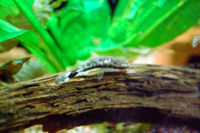Oto (Otocinclus mariae)
From The Aquarium Wiki
Otocinclus mariae
57 Litres (15 US G.)
2.5-3.8cm (1-1.5 ")
Freshwater
6.0 - 8.0
21.1-26.1°C (70 -79 °F)
8-20 °d
1:2 M:F
3-5 years
Family
Loricariidae
Contents
Additional names
Origin
|
|
This section requires expansion with: Location where this animal is found in the wild. |
Sexing
- Difficult. Females are slightly bigger than males.
Tank compatibility
- An excellent peaceful community fish. They are best in groups of their own kind.
- There are records of suckermouth fish sucking on slime coats of slow moving large bodied fish such as Angelfish and Discus. However it should be noted that the Otocinclus is one of the few sucker-mouth species which feed almost exclusively on algae. Typically the suckermouth species that attack the slime coats of other fish are the omnivores Pleco's or Chinese algae eaters.
Diet
- Otos will mainly graze on some soft algaes, primarily diatoms, and blanched vegetables such as Zucchini (Courgette), Carrot, Potato and Cucumber. They may also accept some algae wafers, but it can take some time to wean them onto these. They will not eat hair algae or green spot algae.
Feeding regime
- They eat algae virtually all the time, so ensure they get enough.
Environment Specifics
- A planted aquarium is a must. Ensure you get them in decent numbers at least 3. They are a nervous fish if not kept in groups and have been know to die from stress if not kept as so. As this small fish eats whilst resting on a surface, they are easy targets for larger fish in the wild. Prefers to rest on vertical surfaces such as the glass or slate, will also rest on broad leaves.
Behaviour
- They tend to rest on any object, including the front glass so you'll get plenty of views of their underside.
Identification
- The colouration on this Oto differentiates from other similar Otos in a very subtle way. The belly is pale with a bold black lateral line running from the nose to the caudal peduncle, it sometimes breaks before the caudal fin. The top half of the body is mottled grey. On the caudal peduncle is large black diamond shape, it should not be rounded and be quite angular. There are two vertical black bands visible on the otherwise-white caudal fin.
- This fish is often incorrectly identified as Otocinclus affinis, Otocinclus macrospilus or Otocinclus vittatus.
Special note
- These peaceful community fish are often starving when you see them in the average pet shop and consequently they have a reputation of having a high mortality rate within the first month of ownership.
- Ensure that you look at their bellies carefully in the shop and if they look very thin or hollow bellied then tell the shop to feed them more algae tablets. These fish need to eat all the time.
- When you get them home, let them settle into a quiet tank and put in plenty of algae tablets for them to chew on. The first week is fairly critical.
Pictures
External links
- Fishbase (Mirrors:
 )
)

